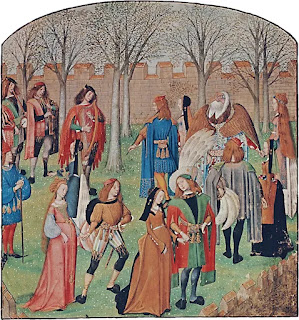From my book, The Theory of Iconic Realism..., p. 47:
The medieval poem Roman de la Rose, written by Guillaume de Lorris and Jean de Meun in the 13th century, takes place in a medieval garden and represents the experience of love and desire through the dream of a twenty-year-old man. The authors use allegorical characters such as Reason, Envy, Genius, Old Age, Fair Welcome, and the god of Love to advise this young lover, as he discovers his inner motivation and develops needed courage to seek the desire of his heart in the form of a beautiful rose. Within the poetics of Roman de la Rose the writers have interwoven ideals that pertain to intuitive thought by associating visual iconography with the lexicon it illustrates.
The rose represents a young woman in the setting of a realistic medieval castle. Although the authors create an aristocratic presentation of courtly love by the placement of the rose in this garden as a young man’s desirous fantasy, the reality is that a young man would not likely fall in love with a flower. However, the writers situate a sense of game playing with the semantics of the text and image, transporting the telling of this tale as a primary source of entertainment and enlightenment of designated cultural restraints within an aristocratic community, utilizing iconic realism as a source of enlightenment for their audience. This enlightenment involves the medieval male audience recognizing the sensitivities and complex thinking of the women in their lives.


